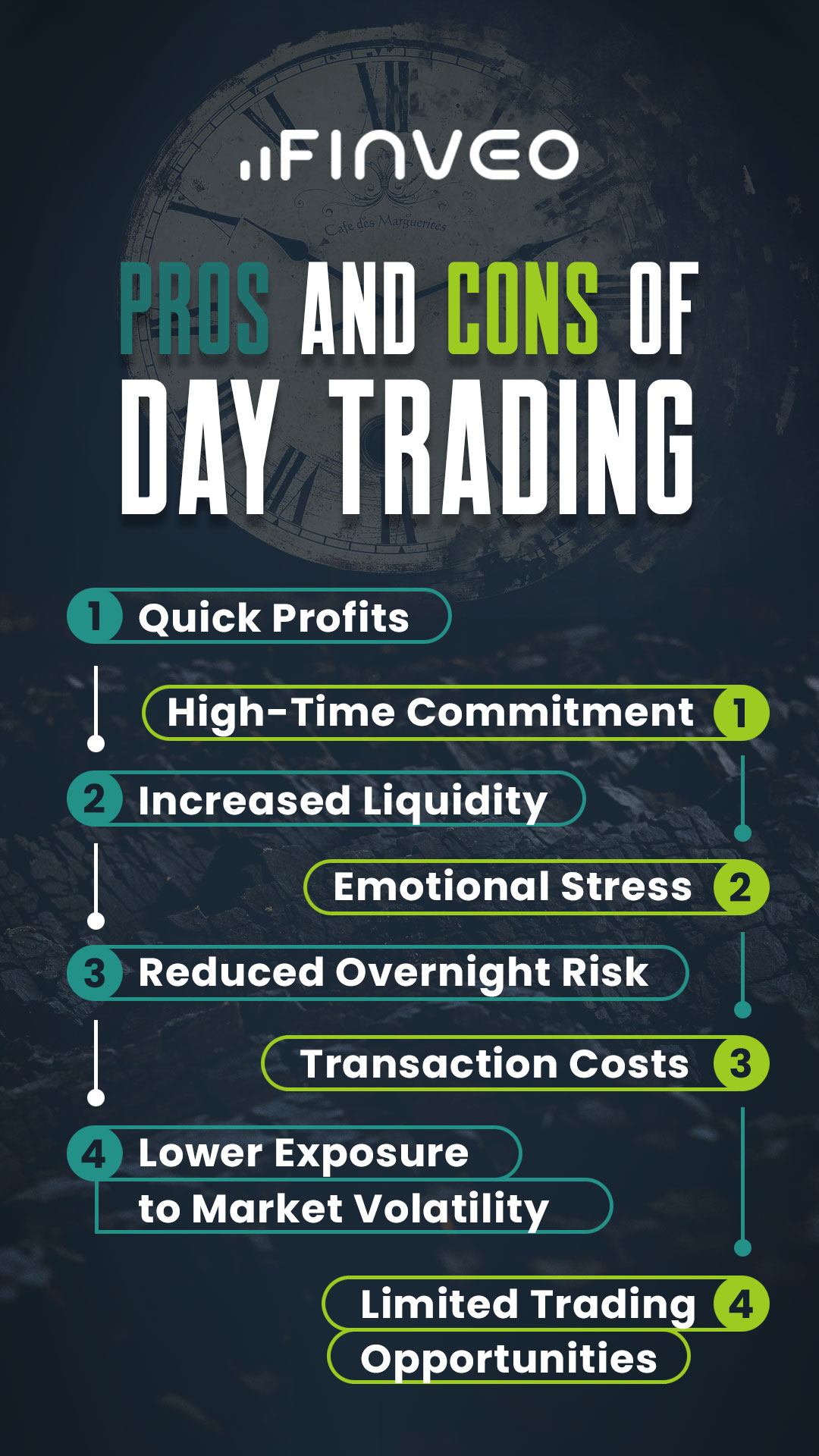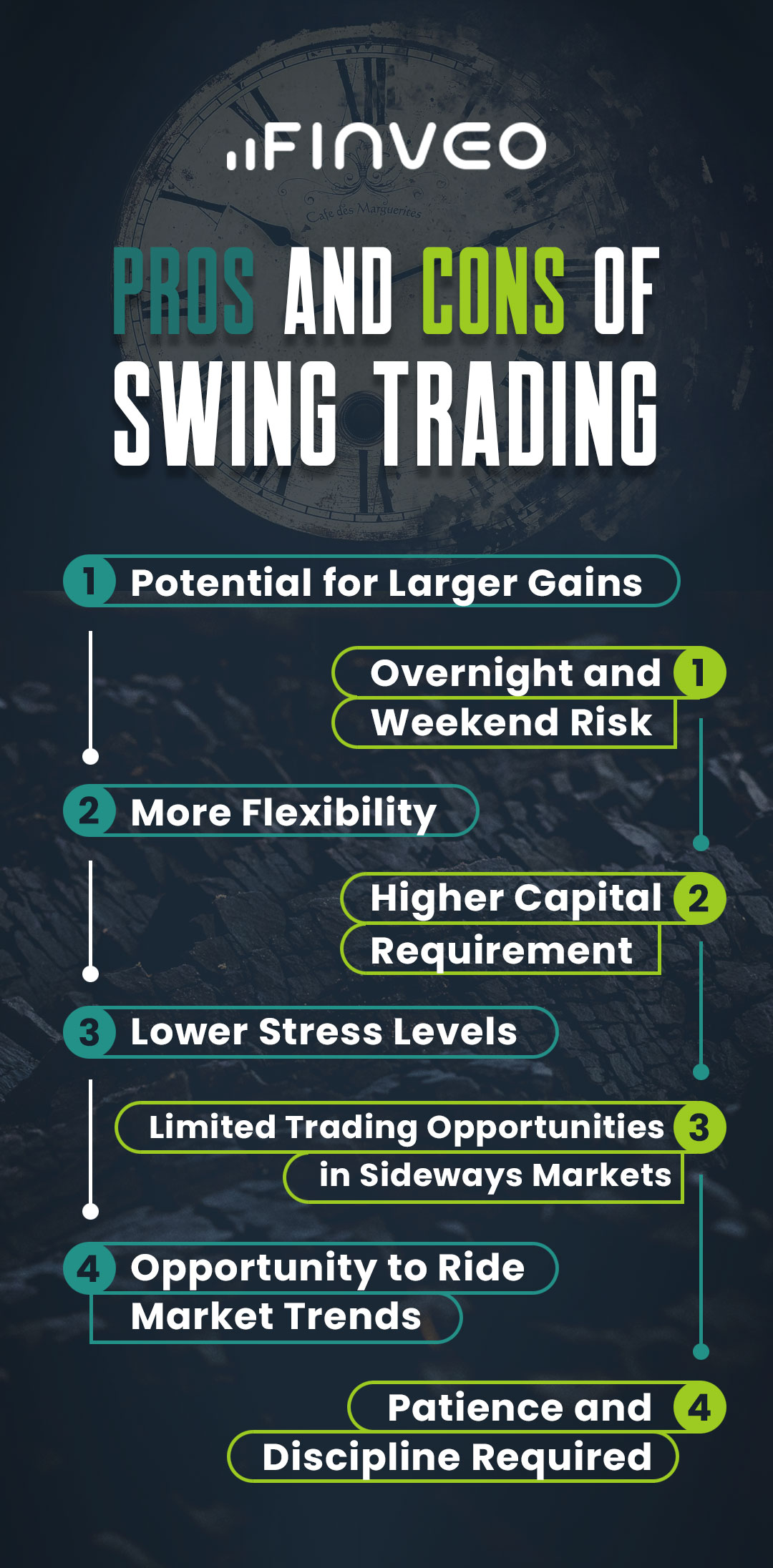When it comes to investing in the financial markets, traders have a plethora of strategies to choose from. Two popular approaches are day trading and swing trading. Day trading involves executing trades within a single day, while swing trading aims to capture larger price moves over a few days to several weeks. In this article, we will delve into the pros and cons of day trading and swing trading, exploring the strategies, risks, and potential rewards associated with each. By understanding these factors, investors can make informed decisions and select the approach that aligns with their goals and risk tolerance.

Pros of Day Trading
Quick Profits: Day traders aim to capitalize on short-term price movements, which can lead to rapid profit opportunities. By actively monitoring the markets and executing multiple trades within a day, day traders can potentially generate quick returns.
Increased Liquidity: Day trading primarily focuses on highly liquid assets, such as stocks and currencies. This high liquidity enables traders to enter and exit positions swiftly, minimizing the risk of being stuck in illiquid investments.
Reduced Overnight Risk: Unlike swing trading, day traders close all their positions before the market closes. This approach eliminates the risk associated with overnight market movements, news events, or gaps in prices that can negatively impact swing traders.
Lower Exposure to Market Volatility: Day traders aim to profit from short-term price fluctuations and are less affected by long-term market trends. This reduced exposure to market volatility can be advantageous during periods of uncertainty or market instability.
Cons of Day Trading
High-Time Commitment: Day trading requires constant monitoring of the markets and real-time decision-making. It demands significant time and attention, making it unsuitable for individuals with other commitments or limited availability.
Emotional Stress: The fast-paced nature of day trading can lead to high levels of stress and emotional decision-making. Traders must control their emotions and stick to their strategies, as impulsive actions can result in losses.

Transaction Costs: Frequent buying and selling of securities in day trading can accumulate substantial transaction costs. Commissions, fees, and spreads can eat into profits, making it crucial for day traders to carefully consider the impact of these costs on their overall returns.
Limited Trading Opportunities: Day trading is restricted to market hours, typically when the exchanges are open. This limitation can result in missed opportunities outside regular trading hours, such as overnight price movements or global market news.

Pros of Swing Trading
Potential for Larger Gains: Swing traders aim to capture larger price moves over a few days to several weeks. This approach allows them to potentially profit from significant market trends, resulting in higher returns compared to day trading.
More Flexibility: Swing trading offers traders the flexibility to pursue other activities while holding positions for longer durations. It caters to individuals who have limited time availability or prefer a less intensive approach to trading.
Lower Stress Levels: Compared to day trading, swing trading involves fewer trades and less frequent decision-making. This reduced activity can alleviate the emotional stress associated with constantly monitoring the markets and making quick decisions.
Opportunity to Ride Market Trends: Swing traders aim to capture medium-term market trends, which can result in substantial profits if identified correctly. By holding positions for a longer duration, swing traders can take advantage of market momentum and ride the trend for potentially larger gains.
Cons of Swing Trading
Overnight and Weekend Risk: Unlike day trading, swing traders hold positions overnight and over weekends. This exposes them to the risk of unexpected market events, news releases, or gaps in prices that can lead to significant losses if not properly managed.
Higher Capital Requirement: Swing trading typically involves holding positions for a longer duration, which may require a larger capital base compared to day trading. Traders need to account for potential market fluctuations and maintain sufficient funds to withstand potential losses during extended holding periods.

Limited Trading Opportunities in Sideways Markets: Swing trading relies on identifying and capitalizing on market trends. In sideways or range-bound markets, where prices move within a narrow range, swing traders may experience limited trading opportunities and struggle to generate profits.
Patience and Discipline Required: Successful swing trading requires patience, discipline, and adherence to a well-defined trading plan. Traders must resist the temptation to make impulsive decisions based on short-term market fluctuations and stick to their predetermined strategies.
Risk Management
Both day trading and swing trading require robust risk management strategies to protect capital and minimize potential losses.
In day trading, since trades are executed within a single day, stop-loss orders are commonly used to limit downside risk. Traders set predetermined price levels at which they will exit a trade to minimize losses if the market moves against them. Additionally, day traders often employ strict position-sizing rules to control the amount of capital allocated to each trade.
For swing trading, due to the longer holding period, stop-loss orders may be placed at wider price ranges to allow for market fluctuations. Traders need to consider the potential risk exposure during overnight or weekend gaps. Position sizing remains crucial in swing trading as well, ensuring that each trade's potential loss is within acceptable limits.
Market Analysis
Both day trading and swing trading rely on market analysis to identify potential trading opportunities.
Day traders often utilize technical analysis, focusing on short-term price patterns, trends, and indicators. They use real-time market data and charts to identify entry and exit points for quick trades. News events and market sentiment can also impact day trading decisions, and traders may keep an eye on economic releases or company announcements that could significantly impact stock prices.
Swing traders typically employ a mix of technical and fundamental analysis. They aim to identify medium-term trends and look for stocks or other assets with favorable prospects. Technical indicators, chart patterns, and trend analysis are combined with a deeper analysis of company fundamentals, industry trends, and market conditions. This comprehensive analysis helps swing traders to select positions with the potential for sustained price moves.
Psychological Considerations
When it comes to maintaining a disciplined approach, both day trading and swing trading require traders to manage emotions and be well-prepared.
Day trading's fast-paced nature can lead to heightened emotions and impulsive decision-making. Traders must cultivate discipline and stick to their trading plan, avoiding the temptation to chase quick profits or deviate from their strategies. Maintaining a calm and rational mindset is crucial in managing risk effectively and making sound trading decisions.
Swing trading offers a relatively lower level of stress, given the longer holding periods. However, swing traders may face challenges in staying patient during periods of market consolidation or when trades are taking longer to unfold. It's essential for swing traders to maintain confidence in their analysis and exercise patience to allow trades to play out according to their plan.
Final Thoughts
Day trading and swing trading are distinct trading styles, each with its own set of pros and cons. Day trading offers quick profits, reduced exposure to market volatility, and increased liquidity but demands a significant time commitment and can be emotionally challenging. Swing trading provides the potential for larger gains, flexibility, and lower stress levels but involves overnight and weekend risk, higher capital requirements, and demands patience and discipline.
Ultimately, the choice between day trading and swing trading depends on individual preferences, risk tolerance, time availability, and trading objectives. Traders should carefully evaluate their own circumstances, educate themselves about the strategies, and consider practicing with virtual demo accounts to gain experience and confidence before committing to real capital. Whichever approach is chosen, a solid understanding of the markets, effective risk management, and a disciplined mindset are crucial for success in the dynamic world of trading.
So, which trading style do you prefer: day or swing trading? Try both with our free demo account and gain real profits with our live accounts!










